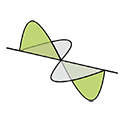Why are soil maps created?
In order to create application maps (fertilizer, seeding, soil tillage), you need basic data. Yield maps or aerial photographs are often used for this. However, the disadvantage is that it is only possible ro react to data with a significant time delay. NDVI (Normalized Difference Vegetation Index) and aerial photographs also do not really allow any conclusive statements to be made about the soil structure, but instead describe the current vegetation situation at the time the image was taken. They only actually show symptoms rather than the causes.
Electrical conductivity, on the other hand, is affected by soil type, compaction, moisture content, organic residues and salt content. This means soil parameters can also be calculated from conductivity values using appropriate algorithms and displayed in map form.
The following maps can be produced automatically with the TSM:
- Electrical conductivity
- Soil zones
- Relative water content
- Vertical horizon depth

Acquire data and generate maps quickly and at any time
A field should be treated in a way that preserves the soil and crops as much as possible. Sensors with direct soil contact (disk harrow, slides) are therefore usually only used on empty surfaces.
The TSM, on the other hand, can be installed on any towing vehicles and is also able to record data during a conventional tillage cycle without another pass being required. As the TSM functions contact-free, the crops will not be affected.


Users can create soil maps from the recorded data file immediately after the pass with the TSM. The zones are mapped to begin with so that more precise and therefore fewer soil samples can be taken.
Reduce the number of soil samples
Soil zone maps simplify soil sampling and significantly reduce the work load compared to the grid method. An example for a 40 ha field for comparsion:
With the TSM
navigate at a distance of 12 m and at 25 km/h, on-site creation of a soil zone map and subsequent collection of 4 soil samples: time taken 2 h 15 min.
Without TSM (grid samples)
40 samples (10 min per sample): 6 h 40 min; plus manual map creation using GIS software (total approx. 8 h)
Generate more accurate results
Arguably more important than the speed of the entire process is that the soil sampling delivers considerably more accurate results, especially with heterogeneous soils. Nobody wants to produce inaccurate application maps in precision agriculture.


Positioned opposite each other above are field zone maps that were created by measuring the conductivity (left) and through grid samples (right). It is noticeable that the map created with grid samples has a significantly coarser resolution. In this example, only 8 (marked in green) of the 40 grid fields would actually have homogeneous soils. All other zones (orange-red shades) would actually be mixed zones. The average values obtained in the grid would, of course, be less relevant for site-specific applications.
While the zonal borders can be determined relatively precisely using sensor technology, in grid sampling the grid size is a limiting factor in practice. The more soil samples are taken, the more precise the maps will be, but there is also an exponentially rising work load involved (in the example below over 26 hours for 160 samples instead of 6 h 40 min for 40 samples). However, the total area of the grid cell with homogeneous soils is increased from 20 % to 32 % (again displayed in green).


red: grid cell with three or more soil types
orange: grid cell with two soil types
green: grid cell with one soil type
TSM Return on investment
1. EC mapping
The prices of service providers for creating electrical conductivity maps vary from a few euros to 40 or more euros per hectare depending on the information provided (raw data via the analysis to application maps).
If you assume an attainable market price of € 5/ha and own costs of € 1.5/ha (field time, vehicle) purely for EC mapping, a gross profit of approx. € 30,000 is left over after mapping 8,500 ha (more than the investment in a TSM mapping bundle). This surface can be scanned with the Topsoil Mapper in approximately 10 working weeks. Weather conditions do not have to be taken into account with the TSM.
2. Soil sampling
When considering the bill which details the cost/profit ratio for soil samples (assumption: market price per sample € 25), there is an even quicker return on investment when comparing grid sampling with sensor-based mapping.
Consider, for example, a piece of agricultural land of 1,500 ha divided into 20 ha fields with an average of three zones per field (minimum of 3 soil samples in sensor-based mapping):
A 1 ha sampling grid produces 1,500 samples. At a cost of € 25/sample, the total costs will be € 37,500. This is contrasted with 1,500 ha/20 ha * 3 = 225 * € 25 = € 5,625 for the sensor-based sampling - this means a saving of approximately € 32,000.
Part of this saving can undoubtedly also be passed on to the customer. For the customer, this also means a potentially greater return with significantly more accuarate maps (by eliminating the grid inaccuracies).
Summary
Purchasing a TSM pays off for service providers within a few months through the sale of EC maps and for farmers through the savings from purchased maps.
The sensor-based (selective) soil sampling with TSM also generates major savings compared to the conventional grid sampling. Reducing the number of samples and simultaneously improving the database gives the service provider and farmer clear competitive advantages and cost benefits.



